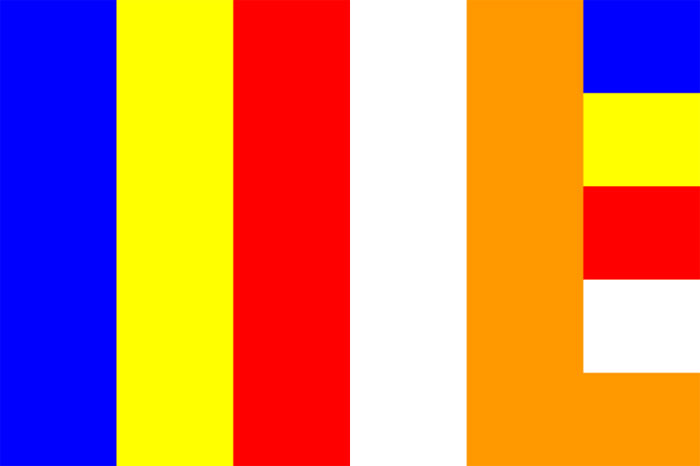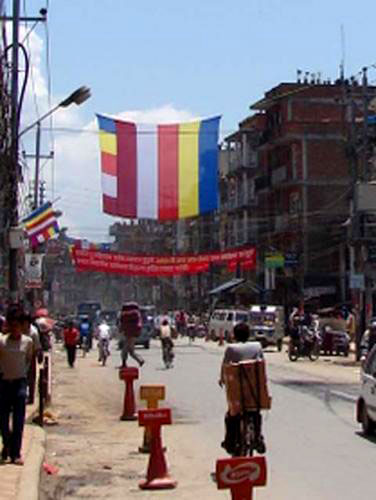THE BUDDHIST FLAG

The flag was originally designed in 1885 by the Colombo Committee, in Colombo, Sri Lanka. The committee consisted of Ven. Hikkaduwe Sri Sumangala Thera (chairman), Ven. Migettuwatte Gunananda Thera, Don Carolis Hewavitharana (father of Anagarika Dharmapala), Andiris Perera Dharmagunawardhana (maternal grandfather of Anagarika Dharmapala), William de Abrew, Charles A. de Silva, Peter de Abrew, H. William Fernando, N. S. Fernando and Carolis Pujitha Gunawardena (secretary).
This flag was published in the Sarasavi Sandaresa newspaper of 17 April 1885 and was first hoisted in public on Vesak day, 28 May, 1885, at the Dipaduttamarama, Kotahena, by Ven. Migettuwatte Gunananda Thera. This was the first Vesak public holiday under British rule.
Colonel Henry Steele Olcott, an American journalist, founder and first president of the Theosophical Society, felt that its long streaming shape made it inconvenient for general use. He therefore suggested modifying it so that it was the size and shape of national flags. Modifications were made accordingly, which were adopted. The modified flag was published in the Sarasavi Sandaresaof 8 April, 1886 and first hoisted on Vesak day 1886.
In 1889 the modified flag was introduced to Japan by Anagarika Dharmapala and Olcott – who presented it to the Emperor – and subsequently to Burma.
At the inaugural conference of the World Fellowship of Buddhists on 25 May 1950, its founder President Professor G P Malasekera proposed that this flag be adopted as the flag of Buddhists throughout the world; this motion was unanimously passed.
The Buddhist flag is a symbol of faith and peace
used throughout the world to represent the Buddhist faith.

The six colors
- Blue (nila). Blue: signifying the concept of loving kindness and peace in Buddhism . The Blue light that radiated from the Buddha’s hair symbolizes the spirit of Universal Compassion for all beings.
- Yellow (pita). Yellow: signifying the Middle Path, that is, the complete absence of form and emptiness . The Yellow light that radiated from the Buddha’s epidermis symbolizes the Middle Way which avoids all extremes and brings balance and liberation.
- Red (lohita). Red: signifying achievement, wisdom, virtue, fortune and dignity.. The Red light that radiated from the Buddha’s flesh symbolizes the blessings that the practice of the Buddha’s Teaching brings.
- White (odata). White: signifying purity, emancipation, that the Dharma will always exist regardless of time or space. The White light that radiated from the Buddha’s bones and teeth symbolizes the purity of the Buddha’s Teaching and the liberation it brings.
- Scarlet (manjestha), or Orange light that radiated from the Buddha’s palms, heels and lips symbolizes the unshakable Wisdom of the Buddha’s Teaching. The Combination Color symbolizes the universality of the Truth of the Buddha’s Teaching. (Burmese Buddhist replaced with Pink.)
- and the mixture of these six colors (prabaswara) of the flag represent the colors of the aura that emanated from the body of the Buddha when He attained Enlightenment under the Bodhi Tree.
The colors symbolize the perfection of Buddhahood and the Dharma.
Therefore, the overall flag represents that:
Regardless of race, nationality, division or color, all sentient beings possess the potential of Buddhahood.
The Horizontal Stripes
The Horizontal Stripes represent the races of the world living in harmony and the Vertical Stripes represent eternal world peace.
The Vertical Stripes
The vertical bars represent eternal peace within the world. In simple terms, the Buddhist Flag implies that there is no discrimination of races, nationality, areas or skin color; that every living being possess the Buddha Nature and all have the potential to become a Buddha.
Sectarian variants
The nonsectarian Buddhist flag is flown over the temples of many different schools. However, some choose to change the colors of the flag to emphasize their own teachings.
- Shin Buddhism in Japan replaces the orange stripes with pink stripes.
- Tibetan Buddhists in Nepal replace the orange stripes with plum stripes.
- Theravada Buddhists in Burma replace the orange stripes with dark green stripes.
- Soka Gakkai uses a tricolor of blue, yellow, and red.




